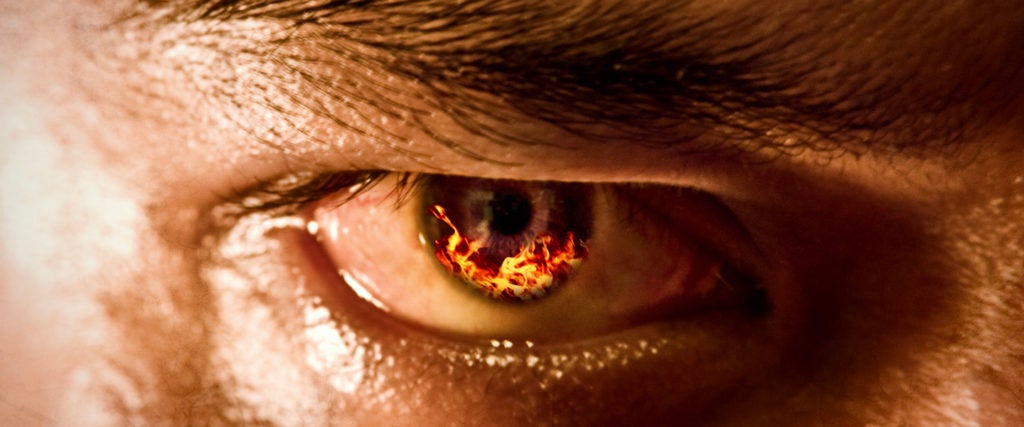When the now-retired MMA fighter RJ Clifford was in his second pro match, he got very angry. Clifford’s opponent, Jarrod Kwity, “literally picked me up over his shoulders and walked me over to the center of the ring like a baby, and slammed me down,” he tells me. “I was so pissed that he was able to do that.”
Once he hit the ground, Clifford scrambled to get in a dominant position and started throwing punches with “a lot more of a visceral feeling in my heart,” he recalls, all of that burning anger leading him straight to victory.
Fighters like Clifford are used to feeling the flush of rage that follows getting punched in the face. This can energize them and drive the brute force behind their punches, but slipping into fight-or-flight mode comes at a cost. “Fight-or-flight is a spontaneous, usually not-well-thought-out, reaction to a perceived threat. It facilitates survival but not optimum performance because the process is reactionary,” explains sports psychologist Bradley Donohue.
When it happens, the amygdala hijacks the brain and inhibits the frontal lobe, which controls emotional regulation and more complex decision-making. As a result, anger becomes more out-of-control and judgment becomes increasingly flawed. Still, Donohue admits that there are benefits to anger in sports, including increased motivation and energy. The challenge is finding a way to be energized by anger without letting it take over completely.
Matt Johnson, professor of psychology and neuroscience at Hult International Business School, recently coined a term for this delicate balance: controlled fury.
To that end, Johnson views anger as a mercurial force. “Those who are able to harness it can galvanize their craft to the next level,” he says. But for those who can’t — particularly those who don’t have a professional sport through which they can channel their rage — anger simply leads to a crash-and-burn.
That said, there are some tools athletes use to harness their anger that might help the rest of us. Donohue, who is also a distinguished professor of psychology at the University of Nevada, Las Vegas, points to The Optimum Performance Program at UNLV, referred to as TOPP — an evidence-based training program for athletes, first responders, performance artists and, really, any professional who wants to learn more about “optimization science.”
Similar to cognitive behavioral therapy, TOPP operates on the premise that our thoughts influence our feelings, which in turn influence our behaviors. If a person wants to change an unhealthy behavior, like, say, regularly yelling at their colleagues, they need to go to the source — the thought that influenced that anger and work on dealing with it directly. The same goes for optimization science, only the end goal isn’t necessarily well-being, but peak performance.
Apart from recognizing triggers, the other piece of the controlled fury puzzle is another area that athletes dominate: working out. Specifically, exercise releases neurotransmitters like endorphins and dopamine, which help us recover from our anger. Not to mention, “consistent exercise requires discipline,” Donohue explains, as does, of course, controlling your anger.
Beyond physical activity, Donahue recommends diaphragmatic breathing and yoga to combat fight-or-flight mode — both keep you more in control of your anger because they allow parts of the brain that deal with emotional regulation to stay active. “Most yoga instructors can assist in learning other useful techniques that are incompatible with anger as well,” he explains. Likewise, ice baths, which tend to be more associated with physical recovery, have also been found to stimulate the vagus nerve and the parasympathetic nervous system, further protecting against fight-or-flight.
Clifford is no stranger to breathwork and ice baths, but what ultimately helped him get a handle on his anger was the self-awareness that came with time and experience. Sure, his anger helped him win that match against Kwity, but he exhausted himself in the process. “The last thing you want to do in a fight is gas out,” Clifford says. “It takes a lot of energy to be angry.”
And so, Clifford learned to stay present by talking himself through his emotions. “It’s just adrenaline and cortisol pumping through your veins because you know that something is going to happen. That’s all it is — biology,” Clifford would tell himself. Or as he puts it to me, “You talk your way logically through your emotions to be able to control them, not suppress them.”
While obviously most of us aren’t professional fighters like Clifford, many of us would benefit from a better balance between pushing anger down and letting it explode. And perhaps there’s an untapped athleticism to emotions that could help us better cope with our rage. If the goal isn’t to “win,” but to communicate through conflict instead, we might start to see much cooler colors as opposed to red.

